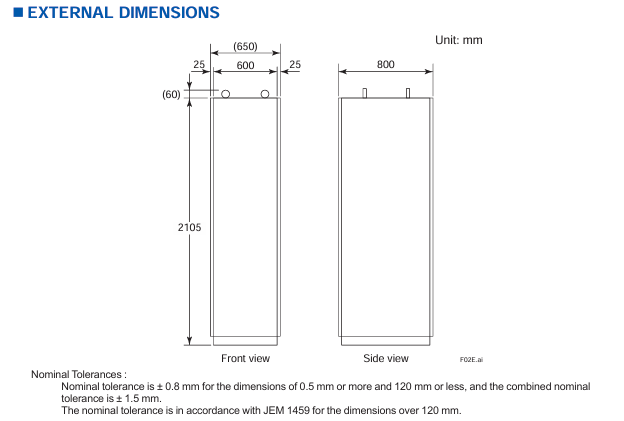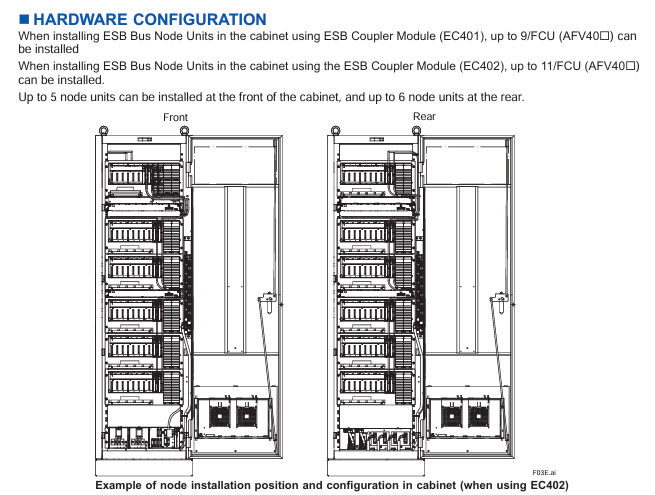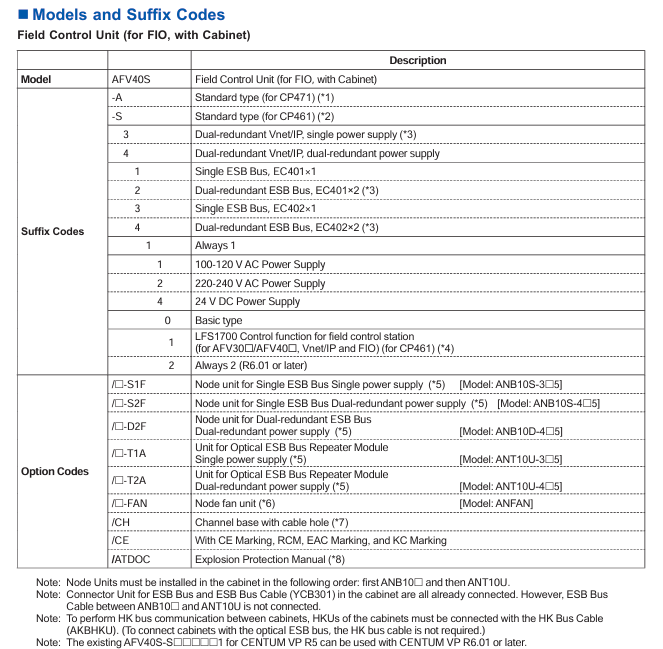

K-WANG


Yokogawa AFV40S/AFV40D Field Control Unit (FCU)
Differentiated design: AFV40S is a single configuration unit suitable for non safety critical scenarios; AFV40D is a dual redundant configuration (with redundant power supply, processor, and communication bus), suitable for critical control circuits that require extremely high reliability, such as reactor temperature control and emergency shutdown systems.
Yokogawa AFV40S/AFV40D Field Control Unit (FCU)
Product positioning
Core role: AFV40S/AFV40D is the core component of the CENTUM VP Field Control Station (FCS), responsible for "field signal acquisition, control logic operation, equipment linkage control" functions, adapted to FIO (Field Input/Output) systems, supports remote I/O node expansion, and is widely used in process industries such as petrochemicals, power, and pharmaceuticals.
Differentiated design: AFV40S is a single configuration unit suitable for non safety critical scenarios; AFV40D is a dual redundant configuration (with redundant power supply, processor, and communication bus), suitable for critical control circuits that require extremely high reliability, such as reactor temperature control and emergency shutdown systems.
Core technical specifications
(1) General basic parameters
Power outage data protection
The main memory is equipped with battery backup, with a maximum power-off protection time of 72 hours and a battery charging time of at least 48 hours, ensuring that control programs and configuration parameters are not lost after power failure and do not need to be reloaded after re powering on.
READY contact output: 3 terminals (NC normally closed, NO normally open, C common terminal), switch contact state in case of FCU fault (such as NC opening and NO closing in case of fault), contact rated parameters: maximum 250V AC/30V DC voltage, 2A current, 125VA power, can be connected to external alarm or monitoring equipment.
communication interface
Vnet/IP interface: Dual redundancy design (AFV40S can provide single/dual power supply, AFV40D requires dual redundancy), used for communication with the operator station (HIS) and other control units of the CENTUM VP system, in compliance with industrial Ethernet standards, ensuring reliable data transmission.
ESB bus interface: AFV40S supports single configuration or dual redundancy, AFV40D enforces dual redundancy and is used to connect FIO node units (ANB10 series) or optical ESB bus relay modules (ANT401/ANT411), expanding on-site I/O access capabilities.
Environmental monitoring (HK function)
Built in HKU (House Keeping Unit) monitors the environmental status of the connected cabinet (such as temperature and fan operation status) through the HK bus or optical ESB bus, and displays the HKU operation status on the HIS (Human Machine Interface), supporting system alarm output.
HK bus parameters: Supports connecting HKUs to cabinets such as ACUKT1/ACUKT2/ACB51/XLCabinet, with a maximum of 9 cabinets connected to a single FCU. The total length of the HK bus cable (AKBHKU) is up to 100 meters (daisy chain connection).
(2) Equipment configuration inside the cabinet
Standard equipment
Each FCU cabinet includes: 1 FCU, 1 distribution board with built-in HKU (supporting single/dual power), 2 vertical power bus units (AEPV7D, 1 front and 1 rear), up to 4 node fan units (ANFAN, 2 front and 2 rear, depending on the number of nodes), and 4 cabinet door fan units (AIP601, 2 front and 2 rear cabinet doors).
FCU module configuration
Power module: Supports PW481/PW482/PW484, dual redundant configuration requires 2 modules of the same model to ensure seamless switching in case of power failure.
Processor module: Supports CP471 (CENTUM VP R6.05 and above) or CP461 (default standard), dual redundancy configuration requires 2 modules of the same model, and only authorized engineers from Yokogawa can perform the replacement of CP461 to CP471.
ESB bus coupler module: Supports EC401 (single/dual redundancy) or EC402 (single/dual redundancy), with two identical modules required for dual redundancy configuration to expand ESB bus nodes (EC401 supports up to 9 nodes, EC402 supports up to 11 nodes).
I/O module: Supports up to 6 non-standard I/O modules, which need to be selected according to the type of on-site signal (such as analog input, digital output) and adapted to the FIO system.
(3) Power supply and power consumption
Description of parameters AFV40S/AFV40D (maximum node configuration)
The supply voltage of 100-120V AC/220-240V AC (50/60Hz) and 24V DC should be specified through suffix codes, such as "1" representing 100-120V AC and "4" representing 24V DC
Maximum power consumption (100-120V AC) 2500VA node unit power consumption at full configuration, reduced power consumption in single node configuration
Maximum power consumption (220-240V AC) 2860VA-
Maximum power consumption (24V DC) 71A-
Power protection dual power redundancy (AFV40D mandatory, AFV40S optional) The distribution board supports dual power input and automatically switches in case of failure
(4) Mechanical and environmental parameters
Cabinet size and weight
Dimensions (width x depth x height): approximately 600mm x 800mm x 2105mm (including cabinet), with dimensional tolerances in accordance with the JEM 1459 standard (± 0.8mm below 120mm, standard tolerances above 120mm).
Weight: The empty cabinet weighs about 240kg, and the maximum node configuration (11 node units) is about 360kg. During installation, it is necessary to ensure that the load-bearing bracket of the cabinet meets the load requirements.
environmental adaptability
Working temperature: -10 ℃~+50 ℃ (depending on the cabinet door fan and node fan for heat dissipation); Storage temperature: -20 ℃~+60 ℃.
Protection level: IP20 (only applicable to internal components of the cabinet, must be installed in a closed cabinet to avoid direct contact with dust and liquids).
Anti interference: Compliant with industrial electromagnetic compatibility (EMC) standards, refer to the CENTUM VP system overview document (GS33J01A10-01EN) for details.

Installation restrictions and configuration requirements
(1) Node unit expansion restrictions
Number and type of nodes
A single FCU can support up to 13 node units, including ESB bus node units (ANB10 series) and optical ESB bus relay module units (ANT10U), and can install up to 11 units in the cabinet (5 in the front and 6 in the back).
Remote node expansion: It needs to be connected through the optical ESB bus relay main module (ANT401/ANT411), and the relay module needs to be installed in slots 1-6 of the FCU (dual redundant configuration needs to be installed in pairs, single configuration needs to be installed in the order of slots 1, 3, and 5). The maximum transmission distance of the optical fiber cable is 50km.
Fan unit selection rules
The number of node fan units (ANFAN) should be determined based on the total number of node units in the cabinet to ensure sufficient heat dissipation and avoid module overheating
Number of required node fan units for the total number of node units (ANB10+ANT10U) in the cabinet
0-4 1
5-9 2
10 3
11 4
(2) Hardware Installation Specification
Cabinet grounding and wiring
Power wiring: M6 screw terminals are used, supporting dual power systems (main/backup power needs to be distinguished), and the input voltage should be consistent with the suffix code (such as 100-120V AC or 24V DC).
Grounding requirements: Use M8 screw terminals, with a protective grounding (PE) resistance of ≤ 4 Ω, to ensure the safety of personnel and equipment in case of leakage.
READY contact wiring: M4 screw terminals are used, and NC/NO contacts need to be selected according to the requirements of external alarm devices.
Module installation sequence
The node units inside the cabinet need to be installed in the order of "ANB10 series (ESB bus nodes) first, then ANT10U (optical ESB relay units)" to avoid communication conflicts.
The dual redundant modules (power supply, processor, ESB coupler) need to be installed in adjacent slots to ensure synchronization of redundant switching signals.
Cable restrictions
HK bus cable (AKBHKU): total length ≤ 100 meters. When connecting multiple cabinets in a daisy chain, the length of each cable segment needs to be included in the total length.
ESB bus cable (YCB301): The pre wiring inside the cabinet has been completed, but the cable between ANB10 and ANT10U needs to be connected on site, and parallel laying with power cables should be avoided (spacing ≥ 300mm) to reduce electromagnetic interference.
Model code and configuration options
(1) AFV40S (Single Field Control Unit) Model Code
Model format: AFV40S - [suffix code 1] [suffix code 2] [suffix code 3] [suffix code 4] [suffix code 5] [suffix code 6] [suffix code 7]+option code Core suffix code meaning:
Description of optional values for suffix code bits
1 (Type) A/S A=compatible with CP471 processor (R6.05 and above); S=Compatible with CP461 processor (default)
2 (Vnet/IP) 3/4 3=dual redundant Vnet/IP+single power supply; 4=Dual redundant Vnet/IP+dual power supply
3 (ESB bus) 1/2/3/4 1=single ESB (EC401 × 1); 2=Dual redundant ESB (EC401 × 2); 3=Single ESB (EC402 × 1); 4=Dual redundant ESB (EC402 × 2)
5 (power type) 1/2/4 1=100-120V AC; 2=220-240V AC; 4=24V DC
Option code (optional as needed):
/ - S1F: Single ESB bus node unit (single power supply, model ANB10S-3 5), is the number of units (1-9/A=10/B=11).
/ - FAN: Node Fan Unit (ANFAN), is the number of fans (1-4, determined by the total number of nodes).
/CH: Channel base with cable holes (rear 300 × 40mm hole, factory equipped with filling plate), but CE/RCM/EMC/KC certification cannot be selected at the same time after selecting this option.
/ATDOC: Includes explosion-proof manual (compliant with ATEX directive, applicable to potentially explosive environments).
(2) AFV40D (Dual Redundant Field Control Unit) Model Code
Model format: AFV40D - [suffix code 1] [suffix code 2] [suffix code 3] [suffix code 4] [suffix code 5] [suffix code 6] [suffix code 7]+Option code Core difference: AFV40D requires dual redundancy configuration, suffix code 2 is fixed as "4" (dual redundant Vnet/IP+dual power supply), suffix code 3 is fixed as "2/4" (dual redundant ESB bus), and option code only supports dual redundant node units (such as/ - D2F, dual redundant ESB node units).

Software requirements and compatible systems
software license
AFV40S/AFV40D require separate purchase of software license, core dependencies:
VP6F1700 Field Control Station Control Function License (GS33J15C10-01EN): Supports the control logic operation of CP461/CP471 processors.
VP6F3100 Project I/O License (GS33J15A10-01EN): Supports I/O node expansion and signal acquisition for FIO systems.
Event Sequence Manager (SEM) compatibility
If SEM functions (event collection, timestamp recording) are required, hardware conditions must be met (such as supporting high-precision time synchronization), please refer to the document "GS33J30D10-01EN" for details.
system compatibility
Only compatible with Yokogawa CENTUM VP integrated production control system, supporting R6.01 and above versions, with CP471 processor requiring R6.05 and above versions; Seamless integration with FIO system, optical ESB bus relay module (ANT401/ANT411), HKU compatible cabinet (ACUKT1, etc.).

Attachments and related products
Standard Appendix
Factory standard: Cabinet door filter (model T9070CB, quantity 2), used to filter the dust in the cabinet inlet air, needs to be replaced regularly to ensure heat dissipation effect.
Related Products
Cabinet Connection Kit: AKT211, used for HK bus or power connection between multiple AFV40 cabinets.
Cabinet side panel: ACB2P, 2 pieces per cabinet (1 on each side) are required for cabinet side protection and need to be ordered separately.
ESB bus cable: YCB301, pre wired in the cabinet already included, additional configuration is required for the connection between ANB10 and ANT10U.
Key application precautions
Effectiveness of redundant configuration
The dual redundancy function of AFV40D must ensure that the "power supply, processor, and ESB bus module" are all of the same model and installed in designated redundancy slots, otherwise automatic fault switching cannot be achieved.
Explosion proof environment use
If used in potentially explosive environments (such as Zone 2), select the/ATDOC option code, obtain the explosion-proof manual, and ensure that the cabinet and node units comply with ATEX/IECEX certification requirements.
Maintenance and replacement
The replacement of processor modules (CP461 → CP471) is only allowed to be operated by authorized engineers from Yokogawa. User initiated replacement will result in the warranty being invalidated; The battery needs to be replaced every 3-5 years to avoid data loss during power outages.

- YOKOGAWA
- Energy Access
- Renewable Integration
- Energy Subsidies
- Energy and Water
- Net zero emission
- Energy Security
- Critical Minerals
- A-B
- petroleum
- Mine scale
- Energy and Gender
- Covid-19
- man-machine
- Reliance
- ADVANCED
- SEW
- ProSoft
- WATLOW
- Kongsberg
- FANUC
- VSD
- DCS
- PLC
- Sewage treatment
- cement
- Yaskawa
- Woodward
- BOSCH Rexroth
- MOOG
- General Electric
- American NI
- Rolls-Royce
- CTI
- Honeywell
- EMERSON
- Automobile market
- xYCOM
- Motorola
- architecture
- Industrial information
- New energy
- electricity
- Construction site
- HIMA
- ABB
- Rockwell
- Schneider Modicon
- Siemens
- MAN
- GE
- TRICONEX
- Control Wave
- ALSTOM
- AMAT
- STUDER
- KONGSBERG
- MOTOROLA
- DANAHER MOTION
- Bentley
- Galil
- EATON
- MOLEX
- Triconex
- DEIF
- B&W
- ZYGO
- Aerotech
- DANFOSS
- KOLLMORGEN
- Beijer
- Endress+Hauser
- schneider
- Foxboro
- KB
- REXROTH
- YAMAHA
- Johnson
- Westinghouse
- WAGO
- TOSHIBA
- TEKTRONIX
- BENDER
- BMCM
- SMC
-
GE Hydran M2-X Enhanced Monitoring
-
ABB REG316 1mrk000809-GA Numerical Generator Protection
-
ABB RED670 1MRK004810 Line differential protection
-
GE SR750-P5-G5-S5-HI-A20-R-E Feeder protection system
-
ABB PFTL301E-1.0KN 3BSE019050R1000 PillowBlock Load cells
-
Kollmorgen S33GNNA-RNNM-00 - Brushless Servo Motor
-
Kollmorgen 6sm56-s3000-g-s3-1325 - Servo Motor
-
Kollmorgen AKM52K-CCCN2-00 - Servo Motor
-
Kollmorgen PSR3-230/75-21-202 - Power Supply
-
Kollmorgen akm24d-anc2r-00 - Servo Motor
-
Kollmorgen AKM22E-ANCNR-00 - Servo Motor
-
Kollmorgen S60300-550 - Servo Drive
-
Kollmorgen B-204-B-21 - Servomotor
-
Kollmorgen AKM21E-BNBN1-00 - Servo Motor
-
Kollmorgen TT2953-1010-B - DC Servo Motor
-
Kollmorgen pa8500 - Servo Power Supply
-
Kollmorgen BDS4A-210J-0001-207C2 - Servo Drive
-
Kollmorgen TTRB1-4234-3064-AA - DC Servo Motor
-
Kollmorgen MH-827-A-43 - Servo Motor
-
Kollmorgen AKM24D-ACBNR-OO - Servo Motor
-
Kollmorgen 00-01207-002 - Servo Disk DC Motor
-
Kollmorgen AKM21C-ANBNAB-00 - Servo Motor
-
Kollmorgen PSR3-208/50-01-003 - Power Supply
-
Kollmorgen 6SM56-S3000 - Servo Motor
-
Kollmorgen DBL3H00130-B3M-000-S40 - Servo Motor
-
Kollmorgen 6SN37L-4000 - Servo Motor
-
Kollmorgen AKM65K-ACCNR-00 - Servo motor
-
Kollmorgen 6SM56-L3000-G - Servo Motor
-
Kollmorgen AKMH43H-CCCNRE5K - Servo Motor
-
Kollmorgen PSR4/52858300 - Power Supply
-
Kollmorgen KBM-79H03-E03 - Direct Drive Rotary Motor
-
Kollmorgen AKM33E-ANCNDA00 - Servo Motor
-
Kollmorgen U9M4/9FA4T/M23 - ServoDisc DC Motor
-
Kollmorgen AKM13C-ANCNR-00 - Servo Motor
-
Kollmorgen AKM43L-ACD2CA00 - Servo Motor
-
Kollmorgen AKM54K-CCCN2-00 - Servo Motor
-
Kollmorgen M-605-B-B1-B3 - Servo Motor
-
Kollmorgen AKD-P00606-NBAN-0000 - Rotary Drive
-
Kollmorgen 6SM-37M-6.000 - Servo Motor
-
Kollmorgen A.F.031.5 - Sercos Interface Board
-
Kollmorgen 918974 5054 - Servo PWM
-
Kollmorgen U12M4 - ServoDisc DC Motor
-
Kollmorgen AKD-B00606-NBAN-0000 - Servo Drive
-
Kollmorgen MV65WKS-CE310/22PB - Servo Drive
-
Kollmorgen 65WKS-CE310/22PB - Servo Drive
-
Kollmorgen EM10-27 - Module
-
Kollmorgen S64001 - Servo Drive
-
Kollmorgen CR03200-000000 - Servo Drive
-
Kollmorgen 6SM57M-3000+G - Servo Motor
-
Kollmorgen BDS4 - Servo Drive
-
Kollmorgen AKD-P00306-NBEC-000 - Servo Drive
-
Kollmorgen AKD-B01206-NBAN-0000 - Servo Drive
-
Kollmorgen STP-57D301 - Stepper Motor
-
Kollmorgen 6SM37L-4.000 - Servo Motor
-
Kollmorgen 44-10193-001 - Circuit Board
-
Kollmorgen PRDR9SP24SHA-12 - Board
-
Kollmorgen PRD-AMPE25EA-00 - Servo Drive
-
Kollmorgen DBL3N00130-0R2-000-S40 - Servo Motor
-
Kollmorgen S406BA-SE - Servo Drive
-
Kollmorgen AKD-P00607-NBEI-0000 - Servo Drive
-
Kollmorgen AKD-P01207-NBEC-0000 - Servo Drive
-
Kollmorgen CR03550 - Servo Drive
-
Kollmorgen VSA24-0012/1804J-20-042E - Servo Drive
-
Kollmorgen N2-AKM23D-B2C-10L-5B-4-MF1-FT1E-C0 - Actuator
-
Kollmorgen 04S-M60/12-PB - Servo Drive
-
Kollmorgen H33NLHP-LNW-NS50 - Stepper Motor
-
Kollmorgen A-78771 - Interlock Board
-
Kollmorgen AKM43E-SSSSS-06 - Servo Motor
-
Kollmorgen AKD-P00607-NBEC-0000 - Servo Drive
-
Kollmorgen E21NCHT-LNN-NS-00 - Stepper Motor
-
Kollmorgen cr10704 - Servo Drive
-
Kollmorgen d101a-93-1215-001 - Motor
-
Kollmorgen BDS4A-203J-0001-EB202B21P - Servo Drive
-
Kollmorgen MCSS23-6432-002 - Connector
-
Kollmorgen AKD-P01207-NACC-D065 - Servo Drive
-
Kollmorgen CK-S200-IP-AC-TB - I/O Adapter and Connector
-
Kollmorgen CR10260 - Servo Drive
-
Kollmorgen EC3-AKM42G-C2R-70-04A-200-MP2-FC2-C0 - Actuator
-
Kollmorgen BDS5A-206-01010-205B2-030 - Servo Drive
-
Kollmorgen s2350-vts - Servo Drive
-
Kollmorgen AKM24D-ANC2DB-00 - Servo Motor
-
Kollmorgen E31NCHT-LNN-NS-01 - Stepper Motor
-
Kollmorgen PRD-0051AMPF-Y0 - Servo Board
-
Kollmorgen TB03500 - Module
-
Kollmorgen 60WKS-M240/06-PB - Servo Drive
-
Kollmorgen M21NRXC-LNN-NS-00 - Stepper Motor
-
Kollmorgen H-344H-0212 - Servo Motor
-
Kollmorgen MCSS08-3232-001 - Connector
-
Kollmorgen AKM33H-ANCNC-00 - Servo Motor
-
Kollmorgen PA-2800 - Power Supply
-
Kollmorgen MTC308C1-R1C1 - Servo Motor
-
Kollmorgen PRDR0091300Z-00 - Capacitor Board
-
Kollmorgen BDS4A-206J-0024/01502D79 - Servo Drive
-
Kollmorgen S20330-VTS - Servo Drive
-
Kollmorgen S20250-CNS - Servo Drive
-
Kollmorgen SBD2-20-1105-WO - Servo Drive Board
-
Kollmorgen M405-C-A1--E1 - Servo Motor
-
Kollmorgen PRD-PB805EDD-00 - Servo Drive
-
Kollmorgen 6SM57S-3.000-J-09-HA-IN - Servo Motor
-
Kollmorgen AKM33H-ANCNDA-00 - Servo Motor
-
Kollmorgen PCB-00030200-04 - PCB
-
Kollmorgen H22SSLB-LNN-NS-02 - Stepper Motor
-
Kollmorgen BJRL-20012-110001 - Module
-
Kollmorgen BDS4A-206J-0001404A - Servo Drive
-
Kollmorgen H-342-H-0802 - Servo Motor
-
Kollmorgen CR10561 - Servo Drive
-
Kollmorgen BDS5A-206-00010-205B2-030 - Servo Drive
-
Kollmorgen BDS5A-206-00010-207B-2-030 - Servo Drive
-
Kollmorgen mcss08-3224-001 - Connector
-
Kollmorgen M-207-B-23-B3 - Servo Motor
-
Kollmorgen PRD-0041200Z-S0 - Encoder/Resolver Card
-
Kollmorgen MH-225-G-61 - Motor
-
Kollmorgen MT308B1-T1C1 - Servo Motor
-
Kollmorgen BDS4A-240J-0001604C83 - Servo Drive
-
Kollmorgen 6SM57-S-3000 - Servo Motor
-
Kollmorgen N-T31V-15-5B-6-MF3-FT1E-C251 - Actuator
-
Kollmorgen PRD-0051AMPA-X0 - Servo Board
-
Kollmorgen CF-SS-RHGE-09 - Cable
-
Kollmorgen DIGIFAS7204 - Servo Drive
-
Kollmorgen S30101-NA - Servo Drive
-
Kollmorgen DIGIFAS7201 - Servo Drive
-
Kollmorgen PRD-0051AMPA-Y0 - Servo Board
-
Kollmorgen AKM23D-EFCNC-00 - Servo Motor
-
Kollmorgen SE10000 - Servo Drive
-
Kollmorgen PSR4/5A-112-0400 - Power Supply
-
Kollmorgen AKM31H-ANCNC-01 - Servo Motor
-
Kollmorgen M-203-B-93-027 - Servo Motor
-
Kollmorgen CP-SS-G1HE-05 - Connector




